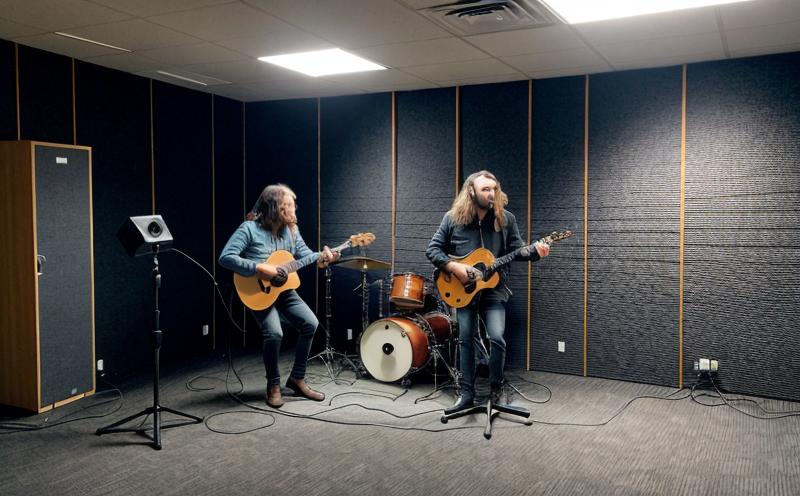ASTM E90 Airborne Sound Transmission Testing
The ASTM E90 standard is widely recognized in the HVAC industry as a crucial method for quantifying the sound insulation properties of building materials and assemblies. This test, also known as "Airborne Sound Transmission Class (STC) testing," evaluates how effectively a material or assembly blocks noise from passing through it. The result of this testing provides an index called the Sound Transmission Class (STC), which can be used to compare the acoustic performance of different products.
The HVAC sector heavily relies on sound insulation in its equipment and design, especially in environments where quiet operation is crucial for occupant comfort and health. In hospitals, for instance, maintaining a low noise level ensures that patients can rest undisturbed by excessive noise from machinery or ventilation systems. Similarly, in offices or schools, reducing background noise enhances concentration levels and overall productivity.
For HVAC equipment manufacturers, ASTM E90 testing is essential to ensure their products meet the stringent requirements of various standards and regulations aimed at improving indoor air quality and acoustic comfort. This test helps manufacturers identify potential issues early in the design process, thereby leading to more efficient product development and reducing costly reworks later on.
The testing procedure involves placing a specimen between two rooms separated by an air gap. A noise source is then introduced into one room while the sound level is measured in the other room using microphones placed at specific locations. The difference in decibel levels between these points provides data that can be used to calculate the STC value.
In practice, this means that HVAC equipment designers must carefully consider not only the structural integrity but also the acoustic properties of each component they select or design. By incorporating ASTM E90 compliant materials into their systems, manufacturers demonstrate a commitment to delivering products that meet both performance and regulatory expectations.
Furthermore, compliance with these standards can significantly impact brand reputation and market competitiveness. Consumers increasingly expect eco-friendly solutions that perform reliably while minimizing environmental footprints. Meeting or exceeding industry benchmarks like those defined by ASTM E90 can set companies apart from competitors in a crowded marketplace.
Finally, it is important to note that while ASTM E90 focuses primarily on airborne sound transmission, other factors such as impact noise and structure-borne noise should also be considered when evaluating overall acoustic performance. Understanding these nuances allows for more comprehensive assessments of materials and systems used in HVAC applications.
Applied Standards
The ASTM E90 standard is based on several key principles derived from established acoustics research, including those outlined in ISO 140-3:2008 and EN ISO 717 series. These international standards form the foundation for consistent measurement practices across different industries.
- ISO 140-3:2008: This document provides guidance on how to determine environmental performance indicators, which includes considerations related to noise pollution control in buildings.
- EN ISO 717 series: This set of standards covers methods for measuring sound insulation in building elements and structures. It specifies procedures for conducting airborne sound transmission tests similar to ASTM E90.
By adhering to these guidelines, laboratories like Eurolab ensure that their testing results are accurate, reliable, and comparable with those produced by other reputable facilities worldwide. This consistency helps maintain high standards within the HVAC industry while promoting fair competition among manufacturers.
Eurolab Advantages
At Eurolab, we pride ourselves on offering comprehensive testing services tailored specifically to meet the needs of our clients in the HVAC sector. Our expertise lies not only in providing accurate and timely results but also in ensuring that all tests conducted are compliant with relevant international standards such as ASTM E90.
We employ highly skilled professionals who possess extensive knowledge of acoustics principles and best practices. Their experience allows them to provide valuable insights into areas where improvements can be made during the design phase or manufacturing process. This proactive approach ensures that our customers receive not just test results, but actionable recommendations for enhancing product performance.
In addition to our technical capabilities, Eurolab offers several other advantages:
- Comprehensive Testing Capabilities: We offer a full range of acoustic tests beyond just ASTM E90 including STC and NRC (Noise Reduction Coefficient) evaluations.
- State-of-the-Art Equipment: Our laboratory is equipped with advanced instruments capable of producing precise measurements under controlled conditions.
- Rapid Turnaround Times: Clients often need quick turnaround times to meet project deadlines. Eurolab prides itself on delivering results efficiently without compromising quality.
- Custom Solutions: Every client has unique requirements, so we offer customized testing packages designed specifically for their projects.
By leveraging these advantages, Eurolab continues to be a leader in providing reliable and accurate acoustic testing services within the HVAC industry. Our commitment to excellence ensures that our clients receive top-notch service every time they choose us for their testing needs.
Environmental and Sustainability Contributions
Sound insulation is increasingly recognized as an important factor in sustainable building design. By improving the acoustic performance of HVAC equipment through ASTM E90 testing, manufacturers can contribute to reducing noise pollution levels both indoors and outdoors. This reduction helps create more comfortable living spaces while also promoting better sleep patterns among residents.
In addition to enhancing indoor comfort, effective sound insulation plays a role in energy conservation efforts by minimizing the need for additional heating or cooling due to cold drafts entering through poorly insulated areas. Consequently, this leads to reduced greenhouse gas emissions associated with fossil fuel consumption.
From an environmental perspective, lower noise levels contribute positively towards biodiversity preservation since excessive urban noise can disrupt natural habitats and wildlife behavior patterns. By prioritizing sound insulation standards like ASTM E90, industries play a vital role in supporting ecological balance alongside economic growth objectives.





